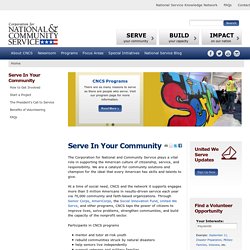

Community Service. Web Sites - Give Them Something to Talk About: Create a Community Around Your Site's Content. You've been told your whole life that talking about others is a bad thing.

(In all honesty, that rumor you started about your frenemy's torrid affair with David Hasselhoff was probably just mean.) In the right context, however, gossiping about others can be beneficial to them. If you can get people talking about your company and its website, for example, half of your marketing will be done for you. And the best way to attract that kind of attention is to start a community around the content on your site. Building a community around your specialty is time-consuming and intensive.
Retention. Managing Your Community As the owner of your community, you do have some responsibilities. Perhaps your most difficult task will be keeping your readers on topic. Furthermore, improve your existing communities. Who is a part of your community is almost as important as what your community represents. Four Steps to Success How can you ensure your success as a community leader? 1. 2. 3. 4. Serve In Your Community. The Corporation for National and Community Service plays a vital role in supporting the American culture of citizenship, service, and responsibility.

We are a catalyst for community solutions and champion for the ideal that every American has skills and talents to give. At a time of social need, CNCS and the network it supports engages more than 5 million Americans in results-driven service each year via 70,000 community and faith-based organizations. Through Senior Corps, AmeriCorps, the Social Innovation Fund, United We Serve, and other programs, CNCS taps the power of citizens to improve lives, solve problems, strengthen communities, and build the capacity of the nonprofit sector. Participants in CNCS programs mentor and tutor at-risk youthrebuild communities struck by natural disastershelp seniors live independentlysupport veterans and military familiesand more. The President’s Call to Service Benefits of Volunteering and Service.
Create The Good: Community Service, Volunteering & Charity Work - AARP. Productivity 101: How to Use Personal Kanban to Visualize Your Work. 6 Things The Most Productive People Do Every Day. Ever feel like you’re just not getting enough done?

Know how many days per week you’re actually productive? About 3: People work an average of 45 hours a week; they consider about 17 of those hours to be unproductive (U.S.: 45 hours a week; 16 hours are considered unproductive). We could all be accomplishing a lot more — but then again, none of us wants to be a workaholic either. It’d be great to get tons done and have work/life balance. And who better to ask than Tim Ferriss, author of the international bestseller, The 4-Hour Workweek? (Tim’s blog is here and his podcast is here.) Below are six tips Tim offered, the science behind why they work, and insight from the most productive people around. 1) Manage Your Mood Most productivity systems act like we’re robots — they forget the enormous power of feelings.
If you start the day calm it’s easy to get the right things done and focus. Here’s Tim: I try to have the first 80 to 90 minutes of my day vary as little as possible. Research shows email: 5 Ways to Make Your To-Do Lists More Effective. To-do lists seem pretty straightforward: A list of all of the tasks you plan to accomplish during any given day or week.

And, really, there are few things more satisfying than drawing lines through each entry. Progress! But, many times, they balloon to unrealistic levels, and we end up feeling overwhelmed and ineffective. That’s usually because we’re using them as a catch-all for every task that’s thrown at us. Instead, our lists should be derived from our larger goals and include tasks that move us toward those big-picture endeavors, says Robert C. 1. When you take a few minutes to write your to-do list the night before, you can hit the ground running the next morning, Pozen advises.